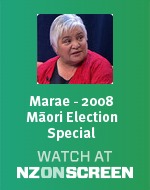It took a while for television to make its mark on New Zealand elections, but since the 1980s the small screen has been the decisive campaign battleground. Politicians and parties seek to sway voters through slick TV advertisements and try to outsmart their rivals in live leaders’ debates. At the same time, campaign and election-night news coverage has become more extensive and lavish, especially since TV3 emerged as a rival to Television New Zealand (TVNZ) in 1989. Here we explore a few of the highlights – and lowlights – of New Zealand elections in the TV age.
1963
- Televised election advertisements appear for the first time but have little impact on a dull campaign. The three main parties – National, Labour and Social Credit – share two hours of pre-recorded speeches, broadcast on each of the four regional TV stations. According to one critic, the leaders look like ‘semi-animated waxworks’ in front of the camera.
- There is no special news coverage on election night. The regional stations announce results during breaks in their scheduled programming.
1966
- The parties’ TV allocations remain limited, and most politicians still appear stiff and uncomfortable on air.
- The New Zealand Broadcasting Corporation (NZBC) produces two election specials during the campaign. From 8 to 9.45 p.m. on election night results are broadcast as they come in.
1969
- In 1969 the style of televised election advertisements begins to change. The airtime allocated to parties increases and the minimum time slots become smaller. The old style of ‘talking heads’ explaining detailed policies is replaced by short, snappy advertisements that are simpler and more emotional. Labour’s ‘Make Things Happen’ advert (which also screens, in full colour, in cinemas) uses split-screen imagery and a poppy theme song to appeal to younger viewers.
- On election night the NZBC’s Ian Johnstone presents a nationwide special with expert commentary from Professor Robert Chapman. While the expert panels have got bigger and the studio gadgetry more sophisticated, the basic format of election-night coverage has remained largely the same ever since.
1975
- The 1975 election is the first held after the introduction of colour TV and a second channel. National causes a stir with colourful cartoon adverts devised by the advertising agency Colenso and animated by the legendary American studio Hanna–Barbera. A string of Russian Cossacks, intended to link Labour policies with Soviet-style communism, dance across the screen and into New Zealand political folklore.
- Labour also runs a controversial advert featuring an image of a piglet – a cheeky reference to National leader Robert Muldoon, who is often called ‘Piggy’ by his enemies.
1984
- One of the key moments in the 1984 campaign is the televised leaders’ debate a week before Election Day. Robert Muldoon, the first New Zealand prime minister to master the medium of TV, finally meets his match in Labour’s David Lange. National’s campaign slogan is ‘New Zealand, you’re winning’ – unfortunately for Muldoon, he loses the debate and the election.
1987
- Fronted by the charismatic Lange, Labour’s adverts feature American TV stars like Ed Asner (Lou Grant) praising the government’s nuclear-free policy, while ‘Pokarekare Ana’ plays in the background. National’s adverts are dark and dramatic, highlighting broken promises and economic turmoil.
1993
- The election campaign is overshadowed by the referendum on changing the voting system from First-Past-the-Post to the Mixed Member Proportional (MMP) system. A well-funded anti-MMP group, the Campaign for Better Government, spends $500,000 on TV adverts in the last week of the campaign; pro-MMP campaigners even accuse them of inserting subliminal messages. But MMP is endorsed by 54% to 46%.
1996
- The Alliance party produces the campaign’s funniest TV advert, which stars an orang-utan ridiculing other parties’ policies.
- The TVNZ leaders’ debate introduces the infamous ‘worm’ – a squiggly line that reflects the instant responses of 100 ‘undecided’ voters in the studio audience. Most politicians hate the gimmicky device, and it is dropped for the 1999 campaign.
2002
- The ‘worm’ returns to TVNZ, and United Future’s Peter Dunne charms it, boosting his party’s vote and bringing another seven MPs into Parliament with him. Meanwhile, Winston Peters’ New Zealand First Party borrows Bob the Builder’s slogan (‘Can we fix it? Yes we can!’) and wins 13 seats.
2005
- National’s animated ‘Tax-athon’ advert, which borrows the memorable Telethon theme tune, recalls the dancing Cossacks of 1975. Its TV spots are backed by a clever billboard campaign, but it isn’t enough to defeat the Labour-led government.
- After TV3 initially excludes them from its live leaders’ debate, Peter Dunne and the Progressive Party’s Jim Anderton take the channel to court to ensure they appear alongside other leaders. Meanwhile, TV3 picks up the ‘worm’ (ditched by TVNZ) and gives it a new name – the ‘Reactor’.
2008
- Following recent elections the long-running Maori current affairs show Marae has brought successful Maori candidates together in its studio. This election special from 2008 features the five Maori Party and two Labour Party MPs.




